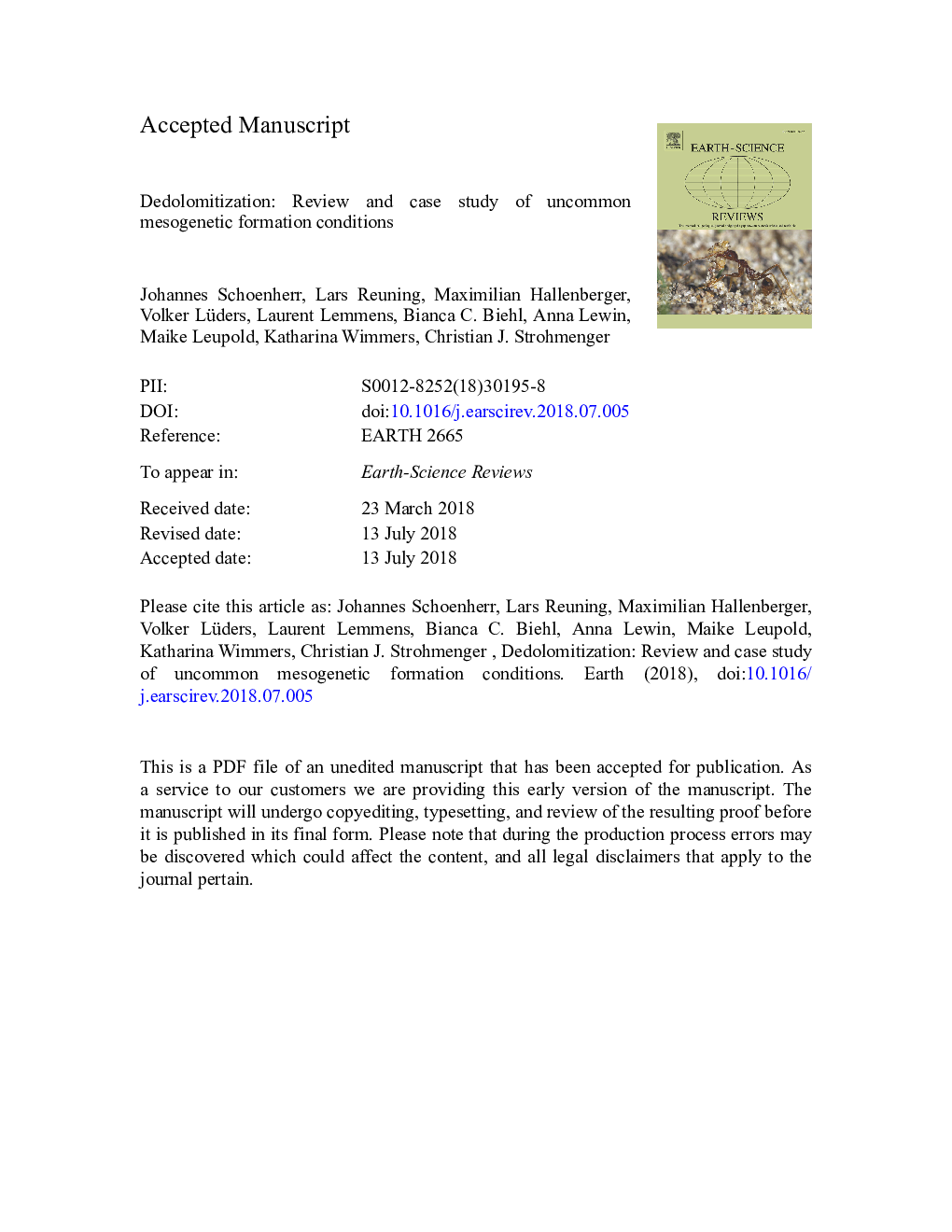| کد مقاله | کد نشریه | سال انتشار | مقاله انگلیسی | نسخه تمام متن |
|---|---|---|---|---|
| 8912910 | 1639918 | 2018 | 79 صفحه PDF | دانلود رایگان |
عنوان انگلیسی مقاله ISI
Dedolomitization: review and case study of uncommon mesogenetic formation conditions
دانلود مقاله + سفارش ترجمه
دانلود مقاله ISI انگلیسی
رایگان برای ایرانیان
کلمات کلیدی
موضوعات مرتبط
مهندسی و علوم پایه
علوم زمین و سیارات
زمین شناسی
پیش نمایش صفحه اول مقاله

چکیده انگلیسی
Dedolomitization converts a dolomite into a calcite, and conventionally is interpreted to form in an eogenetic or telogenetic diagenetic environment where meteoric water dissolves evaporites to supply excess calcium. Hydrologic connectivity between a dolostone and the surface water may then lead to a dedolomitized interval, often times being a diagnostic indicator for an erosional unconformity, subaerial exposure, and/or karst. In contrast to the classic models, we present a case study for pervasive burial dedolomitization, unrelated to meteoric fluids. Dedolomitization of the Zechstein-2-Carbonate (Ca2) gas reservoir in NW Germany is strongly altering reservoir quality on a regional scale. The Ca2 shows a textbook correlation between reservoir quality and mineralogy. Petrographic analyses show that approximately 80% of all observed calcite reveal a dedolomite microtexture, causing a reduction of average matrix porosity by 5 to 10% compared to the dolomite. Dedolomite follows initial layering and abundantly forms massive concretions, which are surrounded by compaction-related curvature of the depositional layering in the dolomite host rock. Such an early burial timing is supported by a slight burial-related shift of ~3Ⱐδ18O and ~1Ⱐδ13C towards lighter values in the dedolomites compared to dolomite. An exceptionally large amount of calcium-rich fluids must have been mobilized to account for >50% of the Ca2 rock volume to be dedolomitized. However, core fabrics related to meteoric diagenesis, such as karst fabrics or typical fresh water stable isotope signatures have been observed neither in the Ca2 nor in over- and underlying anhydrite beds. Instead, excess calcium likely comes from gypsum-to-anhydrite conversion and pressure solution within over- and underlying anhydrites. An influx of strontium-rich waters from the anhydrite beds is indicated by up to 5 times higher strontium contents measured in dedolomite fabrics compared to their dolomite host rock. Homogenization temperatures between 51 and 56â¯Â°C measured in some early fluid inclusions in dedolomite textures further exclude a pristine meteoric water input and suggest fluid entrapment in a burial depth range of 900 to 1400â¯m. Comparing these results with literature data furthermore indicates that mesogenetic dedolomite is either volumetrically underestimated in other carbonate-evaporite settings or formed under unique diagenetic conditions across the Southern Permian Basin during Zechstein times.
ناشر
Database: Elsevier - ScienceDirect (ساینس دایرکت)
Journal: Earth-Science Reviews - Volume 185, October 2018, Pages 780-805
Journal: Earth-Science Reviews - Volume 185, October 2018, Pages 780-805
نویسندگان
Johannes Schoenherr, Lars Reuning, Maximilian Hallenberger, Volker Lüders, Laurent Lemmens, Bianca C. Biehl, Anna Lewin, Maike Leupold, Katharina Wimmers, Christian J. Strohmenger,